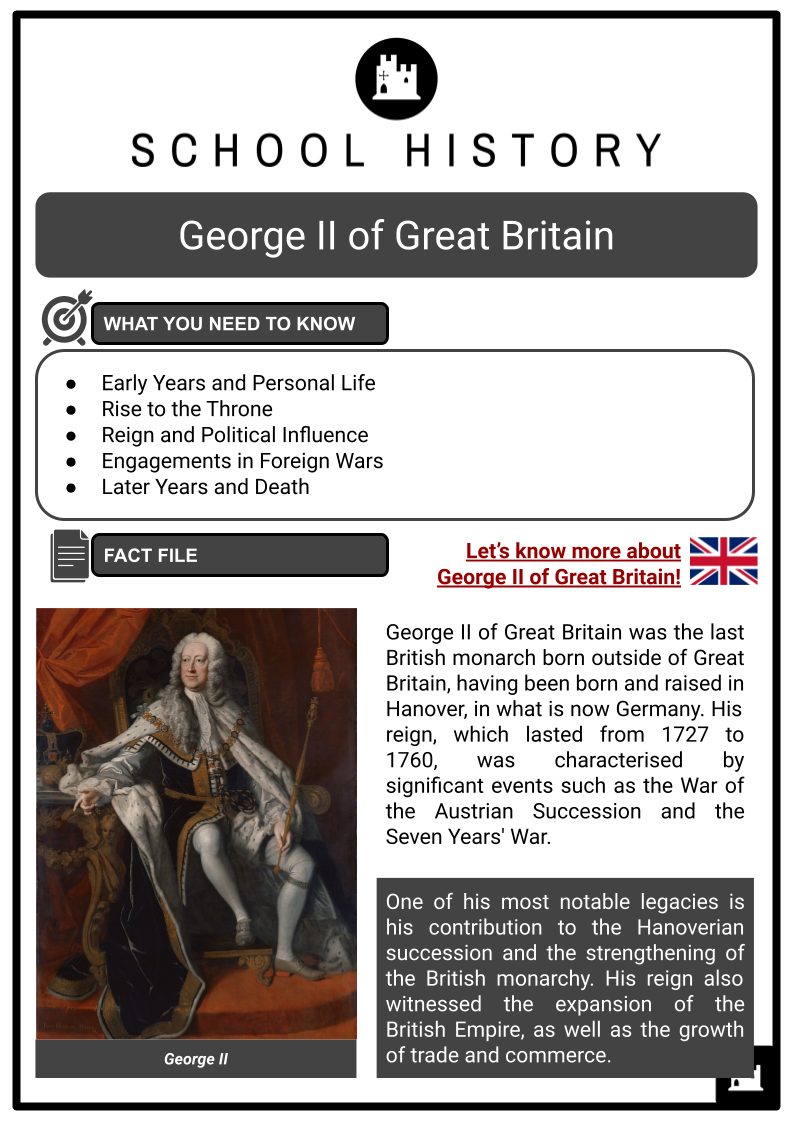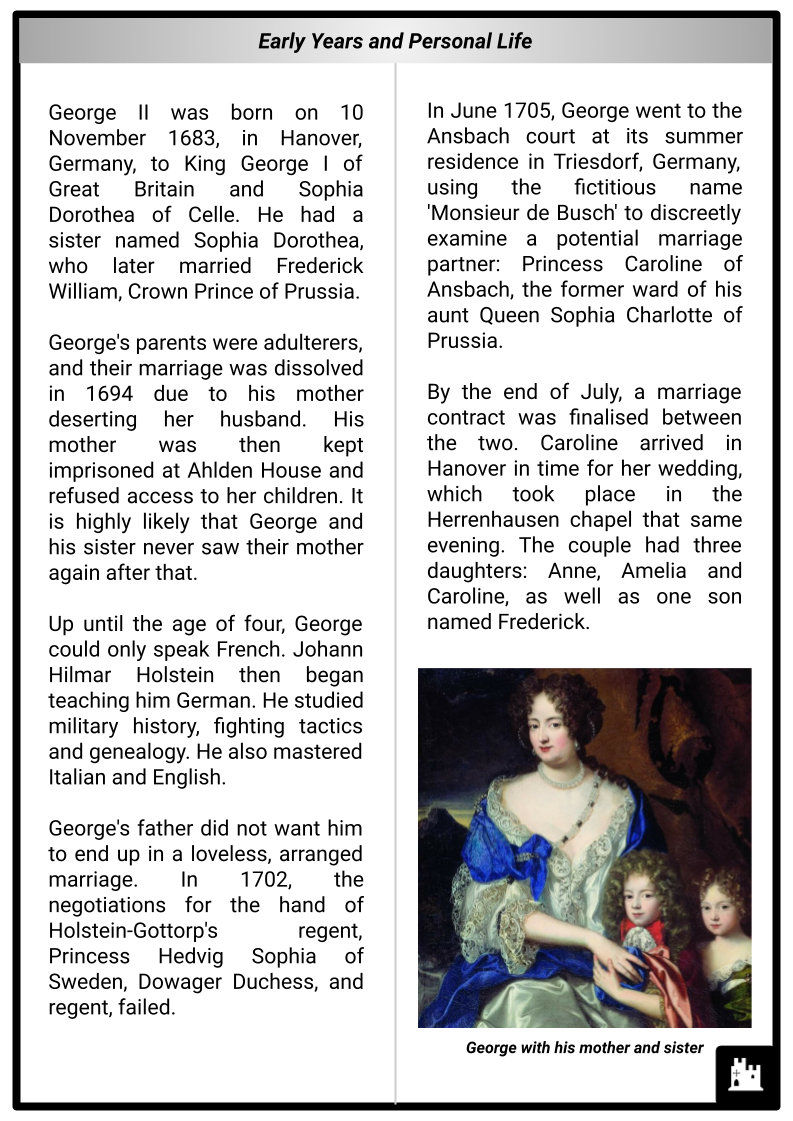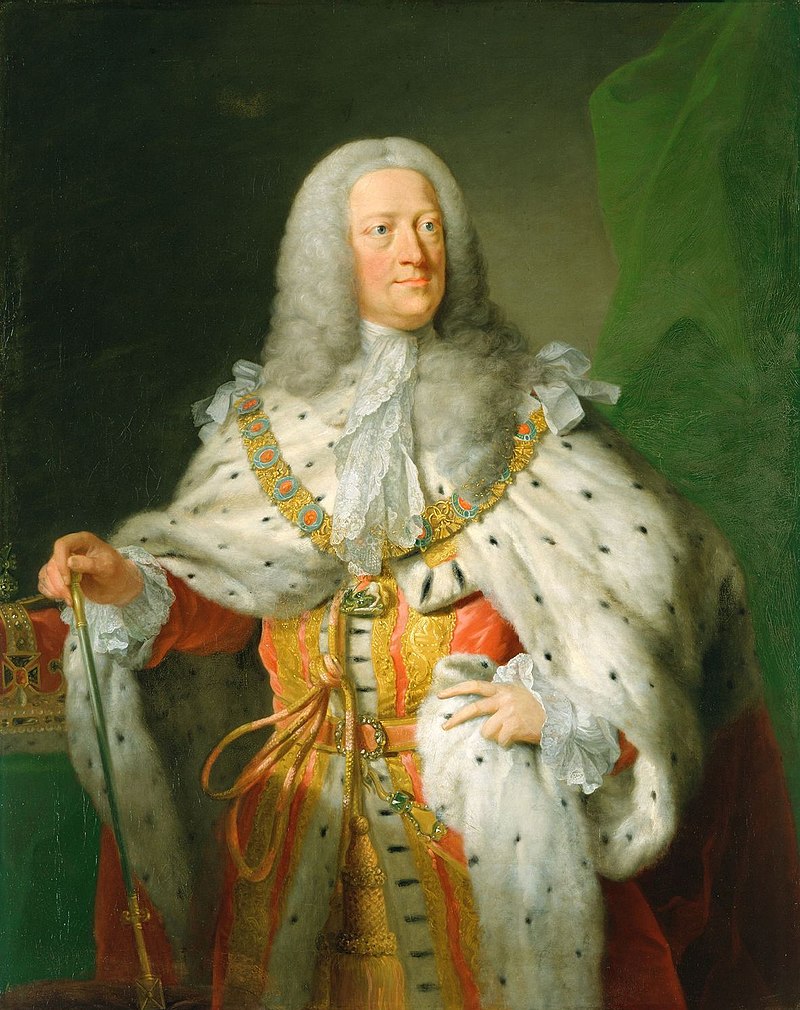George II Worksheets
Do you want to save dozens of hours in time? Get your evenings and weekends back? Be able to teach about George II to your students?
Our worksheet bundle includes a fact file and printable worksheets and student activities. Perfect for both the classroom and homeschooling!
Resource Examples
Click any of the example images below to view a larger version.
Fact File


Student Activities




Summary
- Early Years and Personal Life
- Rise to the Throne
- Reign and Political Influence
- Engagements in Foreign Wars
- Later Years and Death
Key Facts And Information
Let’s know more about George II of Great Britain!
George II of Great Britain was the last British monarch born outside of Great Britain, having been born and raised in Hanover, in what is now Germany. His reign, which lasted from 1727 to 1760, was characterised by significant events such as the War of the Austrian Succession and the Seven Years' War.
One of his most notable legacies is his contribution to the Hanoverian succession and the strengthening of the British monarchy. His reign also witnessed the expansion of the British Empire, as well as the growth of trade and commerce.

Early Years and Personal Life
- George II was born on 10 November 1683, in Hanover, Germany, to King George I of Great Britain and Sophia Dorothea of Celle. He had a sister named Sophia Dorothea, who later married Frederick William, Crown Prince of Prussia.
- George's parents were adulterers, and their marriage was dissolved in 1694 due to his mother deserting her husband. His mother was then kept imprisoned at Ahlden House and refused access to her children. It is highly likely that George and his sister never saw their mother again after that.
- Up until the age of four, George could only speak French. Johann Hilmar Holstein then began teaching him German. He studied military history, fighting tactics and genealogy. He also mastered Italian and English.
- George's father did not want him to end up in a loveless, arranged marriage. In 1702, the negotiations for the hand of Holstein-Gottorp's regent, Princess Hedvig Sophia of Sweden, Dowager Duchess, and regent, failed.
- In June 1705, George went to the Ansbach court at its summer residence in Triesdorf, Germany, using the fictitious name 'Monsieur de Busch' to discreetly examine a potential marriage partner: Princess Caroline of Ansbach, the former ward of his aunt Queen Sophia Charlotte of Prussia.
- By the end of July, a marriage contract was finalised between the two. Caroline arrived in Hanover in time for her wedding, which took place in the Herrenhausen chapel that same evening. The couple had three daughters: Anne, Amelia and Caroline, as well as one son named Frederick.
Rise to the Throne
- George received the title of Prince of Wales upon his arrival in London in 1714, along with his father. He claimed to have no English ancestry in order to gain favour, and he was full of admiration for the English. After his father's six-month return to Hanover in July 1716, George was granted only limited authority to rule in his place.
- George and his father had a strained relationship as a result of the latter's mistrust of George's popularity and his jealousy of it. Following a family argument over the birth of George's second son, George William, in 1717, the King named Lord Chamberlain Thomas Pelham-Holles, 1st Duke of Newcastle, as one of the child's baptismal sponsors. The King ordered George and Caroline to be temporarily confined to their quarters and then exiled his son from St James's Palace.
- George and Caroline, desperate to see their children, snuck into the palace without the King's permission. After giving in to some pressure and allowing them to come once a week, the King eventually gave Caroline complete access. With his father by his side, Prince George William passed away in February 1718 at the age of just three months.

- George was known to be against his father's plans, which included initiatives to broaden Hanover's German lands at Sweden's expense and improve religious freedom in Great Britain. His new London home, Leicester House, became a regular gathering spot for his father's political rivals, such as Lord Townshend and Sir Robert Walpole.
- After the death of his father, King George I, on 11 June 1727, George II ascended to the British throne. He was formally crowned King of Great Britain and Ireland on 11 October 1727.
Reign and Political Influence
- George II reigned over Great Britain and Ireland from 1727 to 1760. Similar to his father, he continued to navigate the complex religious landscape through the implementation of Indemnity Acts and religious policies, such as the Toleration Act of 1730, which aimed to provide greater religious freedom and tolerance within the realm.
- With his ascension to the throne in 1727, the relationship between the monarchy and the government became increasingly complex. One of the key developments during his reign was the emergence of a more assertive Parliament. The Whigs, who had gained power following the 1715 general election, remained in control for much of George's reign. This resulted in a significant shift of political power away from the monarchy and towards the Prime Minister and the cabinet.
George II had musical interests and was a significant patron of the arts. Composer George Frideric Handel was employed by the royal family during his reign.
- The influence of the monarchy became more ceremonial, and real political authority rested with the elected government officials.
- George faced the challenge of maintaining stability within the monarchy and asserting his authority, particularly in the face of tensions with his father.
- The rivalry between father and son had a lasting impact on the dynamics of the royal family and the monarchy as a whole. Their rivalry stemmed from a combination of personal differences and political struggles.
- One key source of tension was his father's close relationship with Sir Robert Walpole. This alliance alienated George, who had his own circle of advisers and counsellors that he preferred to rely on.
- Moreover, his father's reluctance to involve him in matters of governance and decision-making created resentment and frustration on George's part. Despite being groomed to succeed his father, George was often sidelined and marginalised in important state affairs.
- Another instance of the rivalry between George and his father can be seen in their differing approaches to foreign policy. George I, with his background as the Elector of Hanover, often prioritised the interests of his German territories and maintained a cautious stance in international affairs.
- On the other hand, George II, driven by a desire to assert his authority as the reigning monarch of Britain, advocated for a more proactive and assertive foreign policy.
- George II's approach to international relations was characterised by a keen interest in advancing Britain's colonial and maritime interests as well as maintaining a balance of power on the continent.
- Overview of George II's foreign policies:
- Alliances with major European powers: George II prioritised the maintenance of alliances with other major European powers, particularly Austria and the Dutch Republic, during the War of the Austrian Succession in 1740. These alliances were crucial in enabling Britain to project its naval and military power in support of its interests in the ongoing conflict.
- Cultivation of diplomatic relationships: In addition to Austria and the Dutch Republic, George II's government also worked to cultivate diplomatic relationships with other European states, such as Spain and Portugal, to strengthen Britain's position and influence on the continent.
- Alliances during the Seven Years' War: During the Seven Years' War, George II continued to prioritise the maintenance of alliances with key European powers, particularly Prussia and Portugal, in addition to Austria and the Dutch Republic.
- Support for military campaigns and expansion of colonial holdings: George II's government actively supported military campaigns in North America, securing significant territorial gains and contributing to the expansion of British colonial holdings in the region. Similarly, in India, his support for military operations facilitated the acquisition of territories and firmly established British influence in the region.
- Focus on maritime supremacy: George II's support for naval developments and the expansion of the Royal Navy demonstrated his commitment to protecting Britain's maritime interests and securing its position as a dominant naval power.
The Gin Act of 1736 was implemented during George II's reign in an effort to curtail alcohol consumption, which was thought to be a contributing factor to social unrest.
Engagements in Foreign Wars
- Britain and Spain resumed hostilities in 1739, leading to the War of Jenkins' Ear and the War of the Austrian Succession.
- The conflict started as a dispute over Spanish dominance in the Caribbean before merging with the larger-scale War of the Austrian Succession.
- This longer-lasting battle resulted from different European countries opposing Maria Theresa's accession to the Habsburg dominions following the death of Habsburg Emperor Charles VI.
- Britain sided with Maria Theresa, concerned about the balance of power in Europe and the rise of French influence should she fail to secure her throne.
- During the summers of 1740 and 1741, George spent his time at Hanover to partake directly in diplomacy and the management of his German territories, which were deeply entwined in the continental conflict due to their geographical position and political connections.
- The 1741 British general election saw Prince Frederick, George's son, advocate against the ruling party and Prime Minister Sir Robert Walpole.
- Walpole's struggle to maintain a workable majority eventually led to his resignation, and Henry Pelham took over leadership of the administration in 1742.
- John Carteret, 1st Earl Granville, who led the pro-war faction, cautioned that without Maria Theresa on the Austrian throne, French dominance in Europe would be assured.
- With Britain's army having not engaged in significant European conflicts for over two decades, George II approved the funding for 12,000 Hessian and Danish mercenaries to support Maria Theresa's claim.
- Discontent grew among Britons, who became increasingly disenchanted with a war they perceived as more beneficial to Hanover than to British interests. The King's refusal to appoint William Pitt the Elder to the Cabinet, a figure well known for advocating a more British-focused foreign policy, further strained relations between the King and the Pelham-led cabinet.
- The unrest increased as a result of the 1745 Jacobite Rebellion, under the leadership of James Francis Edward Stuart's exiled supporters. The uprising aimed to restore the Stuart dynasty to the British throne, diverting resources and attention from the continental war effort.
- Despite the turmoil, the British forces, along with their allies, participated in several key battles during the War of the Austrian Succession. Among these, the Battle of Dettingen in June 1743 stands out as a particularly notable engagement.
- Here, George personally led his troops and secured a victory against the French army. This battle was significant as it was the last time a reigning British monarch would personally lead troops into battle.
- The conflict continued with the Battle of Fontenoy in May 1745, where British forces, part of an allied army, suffered a notable defeat at the hands of the French. This loss did not deter British efforts, and the Royal Navy proved instrumental in defending Britain's overseas territories and disrupting enemy supplies.
- George's commitment to global conflict extended to the colonies. In North America, the war is often referred to as King George's War, where British forces successfully captured the French fortress of Louisbourg in 1745, only to return it to France at the peace negotiations.
- The war concluded with the Treaty of Aix-la-Chapelle in 1748, where Maria Theresa was recognised as the Archduchess of Austria, though not without concessions. The treaty largely restored the pre-war status quo, which disenchanted many who felt the heavy costs of the war were in vain.
- The ongoing hostilities between France and Britain, especially with regard to North America, resulted in the Seven Years' War in 1756. William Cavendish, the prime minister, resigned in response to George's shortcomings, and William Pitt the Elder was named as the new prime minister and secretary of state.
- In an effort to establish a more stable government, George removed Pitt, but he later reinstated him and made him prime minister.
- The war had multiple fronts, and British dominance increased with victories in the Battle of Arcot and the Battle of Plassey. George, although not living to see the war's conclusion, laid much of its groundwork through his foreign policies.

Later Years and Death
- The gradual cessation of George's involvement in political and military affairs was a defining feature of his later years. As he aged, his health began to decline, and he increasingly relied on his ministers and advisers to manage the day-to-day affairs of the monarchy.
- Despite his diminishing physical presence, George continued to maintain an interest in the affairs of the British Empire and its global engagements. He remained informed about the developments in the Seven Years' War and provided guidance and support to his government.
- By 1760, George was hard of hearing and blind in one eye. On 25 October, he was found unconscious on the floor by his valet. After being helped into his bed, he passed away before his daughter, Princess Amelia, could go to him.
- On 11 November he was laid to rest in Westminster Abbey. A post-mortem revealed that a thoracic aortic dissection was the cause of his death. His grandson, George III, succeeded him.
Image Sources
- https://upload.wikimedia.org/wikipedia/commons/thumb/c/cf/George_II_by_Thomas_Hudson.jpg/800px-George_II_by_Thomas_Hudson.jpg
- https://upload.wikimedia.org/wikipedia/commons/thumb/c/c1/George_I_Elector_of_Hanover.jpg/800px-George_I_Elector_of_Hanover.jpg
- https://upload.wikimedia.org/wikipedia/commons/thumb/e/e3/George_II_1755-1767.jpg/800px-George_II_1755-1767.jpg
Frequently Asked Questions
- Who was George II of Great Britain?
George II was a monarch who reigned over Great Britain and Ireland from 1727 to 1760. He was the last British monarch born outside Great Britain in Hanover, Germany.
- What were some significant events during George II's reign?
Britain was involved in several major conflicts during his reign, including the War of the Austrian Succession and the Seven Years' War. Additionally, the British Empire expanded significantly during this time, particularly in India and North America.
- What was George II's contribution to the development of Britain?
George II's reign saw the consolidation and expansion of British power, particularly through colonial acquisitions and military victories. However, he was more of a figurehead monarch, with real power increasingly in the hands of Parliament and the Prime Minister.
